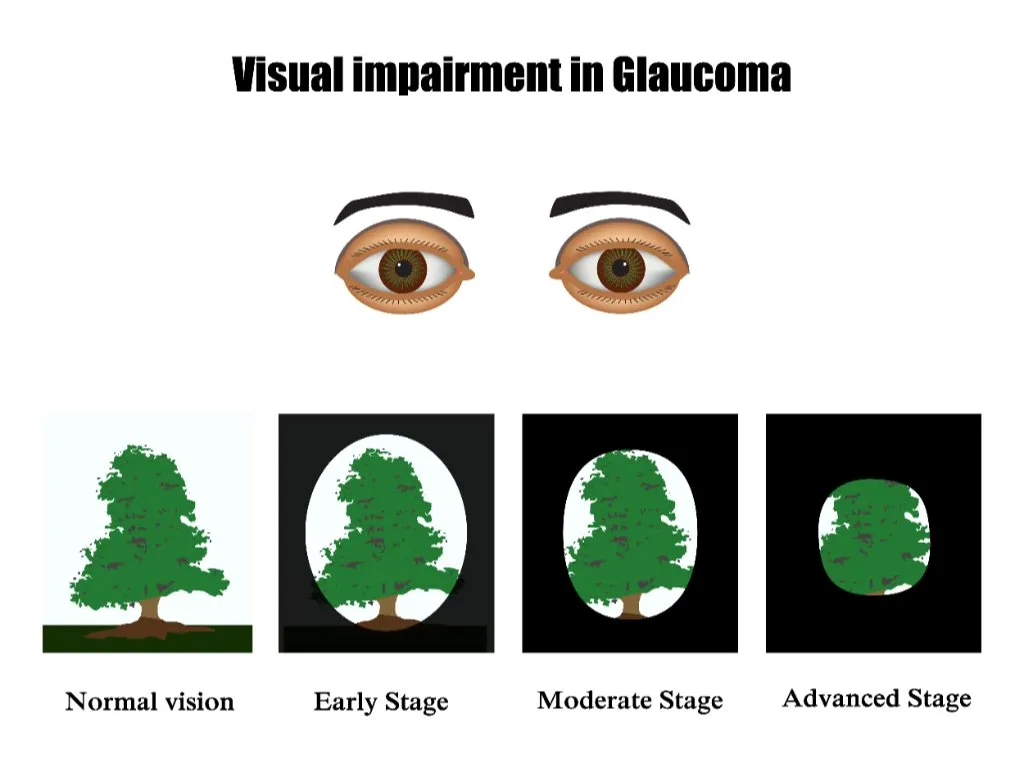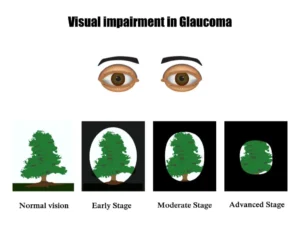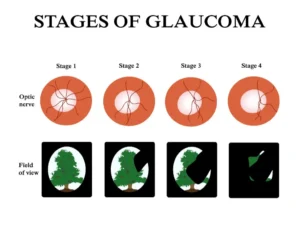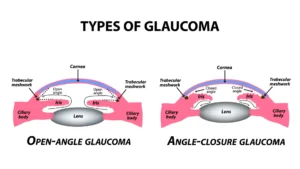The optic nerve acts as the middleman between the eye and brain. When light enters the eye, it’s refracted into the back of the eye (retina) and converted into an electrical signal. The electric signal travels to the brain via the optic nerve, which is where it’s converted into a colored image.
Glaucoma is a group of eye conditions that result in damage to the optic nerve. The damage is generally caused by an increase in intraocular pressure (eye pressure), which is usually a result of fluid backing up in the eye. This can be caused by too much fluid or a blocked drainage angle.
If not treated properly, glaucoma can result in vision impairment, vision loss, and blindness. In fact, glaucoma is the second-leading cause of blindness around the world. The best way to prevent glaucoma is by scheduling a comprehensive eye exam with your eye doctor regularly.
What Does Glaucoma Vision Look Like?
Patients with glaucoma generally report a loss of peripheral vision (reduction in visual field) as the condition progresses – though that progress is slow and most people that have it, don’t know they have it. With that said, the symptoms of glaucoma go far beyond a loss of peripheral vision.
Let’s take a look at some of the most common visual symptoms reported by glaucoma patients and some of the early signs of early or moderate glaucoma:
- Needing more light in order to see clearly or properly
- Blurry vision or distorted vision
- Frequently seeing glares
- Difficulty seeing objects to one side or both sides (peripheral vision)
- Letters appear to fade when reading something
- Seeing too much light or more light than usual
- Some areas in your visual field appear dark or missing completely
- The feeling as if you’re looking through dirty or messy glasses
- The feeling as if you’re looking through clouds or heavy fog
The most frequent visual symptoms mentioned above will be extremely hard to notice during the early stages of glaucoma, but they’ll gradually grow worse over time. Eventually, the patient risks permanent vision loss and even blindness if not treated properly in a timely manner – of course, that’s the worst case.
Who’s at an Increased Risk of Glaucoma?
Glaucoma can happen to anyone and it can happen at any time. With that said, it’s far more common in older adults – more specifically, those above the age of 40 – and those of African American or Hispanic descent. It’s also common in those with parents that have glaucoma.
Aside from that, let’s take a look at who might be at an increased risk of glaucoma:
- Anyone with diabetes, high blood pressure, or heart disease
- Anyone that experiences an eye injury that damages the optic nerve
- Those with a thin cornea (front surface of the eye)
- Anyone with abnormally-high intraocular pressure
- Those that experience complications due to eye surgery
- Those that use steroid eye drops or steroid pills
Although getting regular eye exams is essential for everyone, it’s that much more of a necessity for those at an increased risk of glaucoma. Since symptoms often don’t present themselves in the early stages, an eye exam is often the only way to detect glaucoma early enough to treat.
Different Types of Glaucoma
There are two main types of glaucoma – primary glaucoma and secondary glaucoma – but they each can be boiled down into subtypes. The type of glaucoma is largely dependent on what’s causing the increase in eye pressure. Primary glaucoma is not caused by another condition.
Let’s take a look at four of the most common types of primary glaucoma:
- Primary Open-Angle Glaucoma – roughly 90% of people with glaucoma have open-angle glaucoma, which is caused by increased eye pressure due to fluid not draining from the eye properly.
- Normal-Tension Glaucoma – also known as normal-pressure or low-tension glaucoma, those with normal-tension glaucoma have a damaged optic nerve, despite normal eye pressure levels.
- Acute Angle-Closure Glaucoma – also called acute angle-closure glaucoma or narrow-angle glaucoma, angle-closure glaucoma is a medical emergency that can result in blindness within days if not treated.
- Congenital Glaucoma – roughly 1 in every 10,000 babies are born with an eye problem that prevents fluid from draining properly. This type of glaucoma is called congenital glaucoma.
While primary glaucoma isn’t caused by another medical condition, secondary glaucoma is. The most common types of secondary glaucoma are neovascular glaucoma, pigmentary glaucoma, exfoliation glaucoma, and uveitic glaucoma. Injuries and cataracts can cause glaucoma as well.
Diagnosing & Treating Glaucoma
Determining the type of glaucoma is extremely important to properly treating the disease and preventing any further damage to the patient’s vision. In order to diagnose the type of glaucoma, the eye doctor will perform a series of tests on the eyes to evaluate eye health and function.
During the evaluation, the eye doctor will measure the intraocular pressure, perform a dilated pupil exam, test the patient’s side vision, measure corneal thickness, inspect the health of the optic nerve, and check the function of the drainage angle – among a wide range of other things.
Treating glaucoma generally consists of medication (eye drops), laser treatment (drain fluid out the eye), and surgery – including a trabeculectomy, glaucoma implant surgery, and minimally invasive glaucoma surgery (MIGS). Your doctor will determine the best treatment for you.
Contact Milwaukee Eye Surgeons Today!
Are you experiencing blurred vision or a loss of peripheral vision? Does it look like you’re looking out a tunnel? Do you see a lot of glares in your field of vision or need more light to see clearly? If so, then don’t ignore the signs – you could be suffering from glaucoma, even if you don’t know it!
A regular, annual eye exam with your eye doctor goes a long way in detecting glaucoma and preventing damage to the optic nerve, but sometimes the disease can creep up on a patient. At that point, time is of the essence. Schedule a visit with your doctor and take immediate action.
If you have questions or would like to schedule an eye exam with Milwaukee Eye Surgeons, then contact our team today – we can’t wait to help improve your eye health and function!






